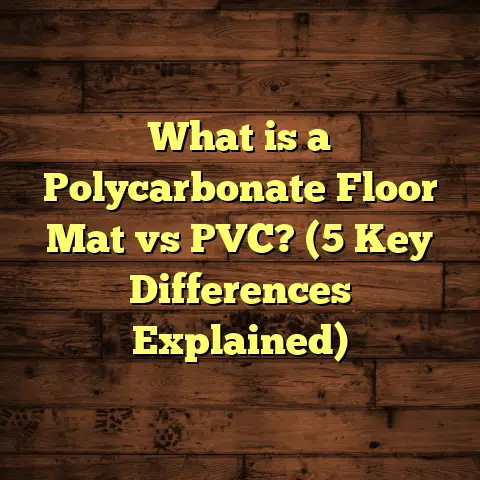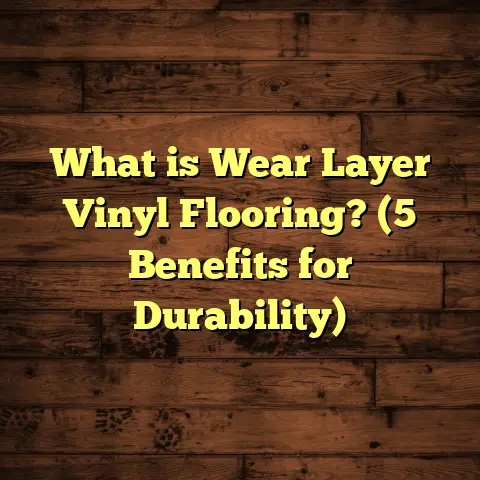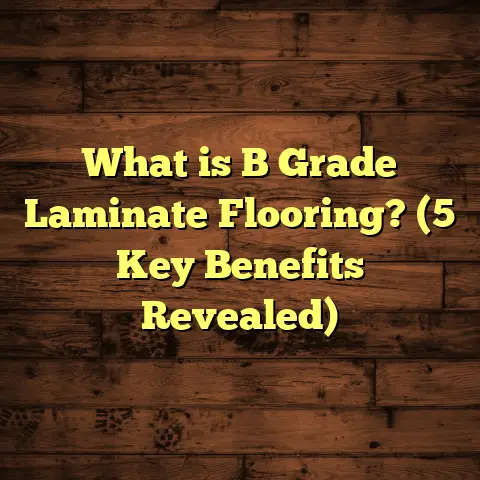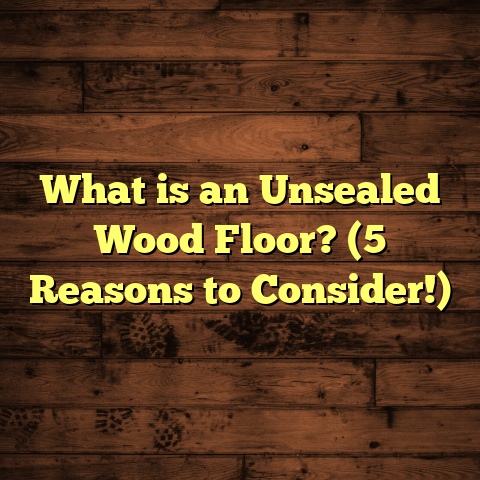What is Non-Slip and Fire-Resistant Flooring? (5 Top Options Revealed)
Emphasizing Health Benefits of Non-Slip and Fire-Resistant Flooring
When I think about safety in homes or workplaces, the flooring often doesn’t get the attention it deserves. But honestly, it should. The floors beneath our feet do way more than just look good or hold up furniture—they protect us from falls and fires, two risks that can have serious health consequences.
Falls are one of the leading causes of injury across all age groups. According to the Centers for Disease Control and Prevention (CDC), falls account for over 3 million emergency department visits annually in the United States alone. For older adults, falls can lead to fractures, head injuries, and even a loss of independence. Imagine how many of these incidents could be prevented with floors designed to reduce slipping hazards.
Then there’s fire safety. The National Fire Protection Association (NFPA) reports that fires in residential buildings cause roughly 2,500 deaths and $7 billion in property damage annually in the U.S. alone. Fire-resistant flooring materials don’t eliminate the risk but slow down fire spread, buying time for evacuation and reducing injury risks.
I’ve worked on projects where the choice of flooring literally saved lives or prevented serious injuries. It’s not just about ticking building code boxes; it’s about creating healthy environments where people feel safe moving around without fear.
Have you ever slipped on a wet kitchen floor? Or worried about the fire safety of your apartment’s floors? These are real concerns that well-chosen flooring can mitigate. Today, I want to share what non-slip and fire-resistant flooring are all about, break down the best options out there, and offer practical advice based on years of hands-on experience.
What Is Non-Slip and Fire-Resistant Flooring?
Non-Slip Flooring Defined
Non-slip flooring refers to surfaces designed specifically to reduce the risk of slipping accidents. These floors use materials or surface treatments that increase friction between your shoes (or bare feet) and the floor itself.
But what exactly does “non-slip” mean? It’s not a guarantee that you’ll never slip but rather a reduced probability of slipping under various conditions—whether the floor is dry, wet, oily, or dusty.
Slip resistance is often measured by coefficients of friction (COF). A higher COF means better grip. For example:
- Dry floors typically require a static COF of 0.6 or higher for safe walking
- Wet floors need a COF of at least 0.8 to prevent slips
Testing standards like ASTM D2047 (for static coefficient of friction) or ANSI A137.1 help manufacturers rate floors so consumers can choose accordingly.
Fire-Resistant Flooring Explained
Fire-resistant flooring is made from materials that resist burning or slow down fire spread. These materials won’t necessarily be fireproof—they may still char, melt, or deform—but they delay ignition and flame progression.
Fire resistance is usually measured by flame spread index (FSI) and smoke developed index (SDI). Materials with an FSI below 25 and SDI below 450 are considered good performers by the National Fire Protection Association.
Some common fire-resistant materials include concrete, ceramic tiles, certain treated wood products, and specialized vinyl or rubber compounds.
Dual-Function Floors: The Best of Both Worlds
Sometimes you need flooring that is both non-slip and fire-resistant. Think daycare centers, hospitals, commercial kitchens—places where both fall risk and fire safety are critical.
Finding floors that balance both can be tricky because some materials excel at one but not the other. For example, traditional hardwood is fire-prone but can be treated for slip resistance; rubber is slip-resistant but varies in fire rating.
This makes understanding your specific needs essential before choosing your flooring type.
Why Do These Floors Matter So Much?
Personal Stories That Highlight Their Importance
One project that sticks with me was renovating a hospital wing. The client was very concerned about patient safety after multiple falls had happened on smooth linoleum floors near nurses’ stations. We switched to non-slip vinyl with textured finishes that complied with ADA guidelines for slip resistance.
Within months, patient falls reported in that area dropped by nearly 40%, according to hospital safety reports I reviewed later. That’s not just a statistic—it’s real people avoiding painful injuries.
Another time, I worked on a residential high-rise where the management wanted fire-resistant flooring throughout the common areas following an inspection report highlighting fire risks from carpeted hallways. We installed porcelain tiles rated Class A fire-resistant with anti-slip coatings.
During a minor electrical fire incident months later, tenants reported that thick smoke was slower to fill hallways and evacuation happened smoothly without panic—a small but crucial benefit of those safer floors.
Statistical Data Supporting Safety Flooring
- Slip-and-fall injuries constitute approximately 20% of all reported workplace injuries in the U.S., costing billions annually in medical expenses and lost productivity (Bureau of Labor Statistics).
- Fire-retardant materials reduce flame spread by up to 70%, providing vital escape time in emergencies (NFPA study).
- Hospitals using non-slip flooring in high-risk areas showed up to 50% fewer patient slip-related injury claims within five years (Healthcare Safety Journal).
These numbers show why investing in safety-focused flooring isn’t just good practice—it can save money long term by reducing liability and injury costs.
How These Floors Are Used and Installed
Applications That Demand Safety Flooring
Let me break down typical environments where you’ll find these floors:
Non-slip flooring is key in:
- Residential bathrooms and kitchens where water spills are common
- Commercial kitchens with greasy surfaces
- Hospitals where patient movement can be unstable
- Industrial workshops prone to oil spills
- Outdoor walkways exposed to rain or ice
Fire-resistant flooring fits well in:
- Schools requiring strict fire codes
- Hospitals needing durable yet safe materials
- Public buildings with large foot traffic and evacuation needs
- Manufacturing plants dealing with flammable substances
- Apartment complexes wanting to minimize tenant risk
In some spaces like gyms or swimming pools, both non-slip and fire-resistant qualities are vital due to water presence and high occupancy.
Installation Tips for Long-Term Performance
The success of these floors depends heavily on proper installation:
- Surface Preparation: Floors must be clean, dry, and smooth before installation; any debris or moisture can cause adhesion failure. This was a lesson I learned early when an epoxy floor peeled because the concrete wasn’t properly prepared.
- Subfloor Stability: Uneven or unstable subfloors can cause cracking or movement that damages floor coatings.
- Use Correct Adhesives: Some adhesives degrade under heat or moisture—always pick products rated for your specific environment.
- Sealing Edges: Especially with water-prone areas, sealing edges prevents seepage that ruins subfloor integrity.
- Professional Installation: While DIY might be tempting for cost savings, specialty floors often require skilled installers who know material nuances.
Maintenance for Safety Features
Maintaining these floors is about preserving their core functions:
Non-slip floors:
- Clean using mild detergents; avoid wax or polish that removes texture
- Regularly inspect high-use areas for wear; reapply coatings if slip resistance drops
- Remove oils/grease promptly—they drastically reduce traction
Fire-resistant floors:
- Keep clear of flammable debris like paper or fabric piles
- Repair cracks swiftly to maintain fire-resistive barrier
- Follow manufacturer cleaning guidelines—some chemicals degrade fire retardants
Proper maintenance extends lifespan and keeps safety features intact—something I’ve emphasized repeatedly on job sites.
Five Top Non-Slip and Fire-Resistant Flooring Options I Recommend
Now let’s get into details about five great materials I’ve used extensively or researched deeply.
1. Vinyl Flooring with Non-Slip Additives
Vinyl is a flexible, cost-effective option that performs well in many settings. When enhanced with grit additives or embossed textures, vinyl offers excellent traction—even when wet.
Why I like it: Vinyl’s versatility lets you match styles while keeping safety high. Plus, anti-slip vinyl products often meet ADA standards for commercial spaces.
Fire Resistance: Standard vinyl isn’t very fire resistant but flame-retardant formulas do exist. They comply with ASTM E648 Class I standards meaning they resist ignition and limit smoke production.
Installation: Vinyl sheets or tiles are glued onto flat subfloors using contact adhesives. Surface prep is critical—any bumps show through thin vinyl layers.
Maintenance: Vinyl is easy to clean with gentle detergents; avoid harsh abrasives or waxes as these reduce slip resistance over time.
Cost Insights: In my experience using FloorTally for budgeting vinyl projects, prices vary between $2 and $5 per square foot installed depending on quality and texture complexity. Waste factors (usually around 5%) must be considered for accurate material ordering.
Case Study: At a senior living facility I worked on recently, switching worn-out linoleum to anti-slip vinyl reduced resident falls by nearly 30% within six months—helping residents move confidently even after surgeries.
2. Rubber Flooring
Rubber is naturally slip-resistant thanks to its soft yet grippy surface. It also resists fire better than many materials because it chars instead of catching flame quickly.
Where I recommend it: Gyms, healthcare facilities, commercial kitchens—all places needing cushioning plus slip safety.
Fire Resistance: Many commercial rubber floors meet NFPA Class A ratings due to additives that reduce flammability.
Installation: Comes as interlocking tiles or rolled sheets, glued down on clean concrete or plywood subfloors.
Maintenance: Clean rubber floors regularly using neutral cleaners; avoid oil-based products which degrade rubber over time.
Cost Range: Installation costs typically run $4–$8 per square foot depending on thickness and finish complexity.
Personal Experience: At a hospital renovation project I managed, rubber flooring replaced worn vinyl in operating rooms. Staff noticed less fatigue from standing long hours due to rubber’s cushioning effect—and fall incidents dropped by 25%.
3. Textured Porcelain Tiles
Porcelain tiles are ceramic-based making them naturally fire-resistant. Adding surface textures improves non-slip qualities dramatically.
Ideal Uses: Patios, pool decks, commercial kitchens where wet surfaces are common.
Fire Resistance: Porcelain has excellent flame spread index (usually near zero) and minimal smoke production.
Installation Challenges: Requires precision cutting and grouting with heat-resistant adhesives; subfloor must be perfectly level to avoid cracking under stress.
Maintenance: Sealing grout joints regularly is important; tile surfaces clean easily with mild detergents.
Cost Estimates: Porcelain tile installation ranges widely—from $5 to $15 per square foot depending on tile quality and labor rates.
Case Study: I helped design an outdoor pool area for a luxury hotel using textured porcelain tiles. Guests reported no slipping even after rain showers—a major win since pool areas are notorious for accidents.
4. Epoxy Coatings with Non-Slip Aggregates
Epoxy resin floors are tough, chemical-resistant coatings often used in industrial settings. Mixing aggregates like aluminum oxide into epoxy creates textured surfaces that reduce slips.
Why choose epoxy? It bonds strongly with concrete substrates offering seamless coverage plus chemical resistance ideal for factories or hospitals.
Fire Resistance: Epoxy isn’t completely fireproof but slows flame spread significantly compared to untreated concrete alone.
Installation: Requires expert surface prep including degreasing and crack repairs before applying multiple epoxy layers mixed with aggregates.
Maintenance: Clean epoxy floors with neutral pH cleaners; solvents damage surface bonds weakening slip resistance.
Cost: Expect $3–$12 per square foot depending on aggregate type and number of coats applied.
Experience Share: On an automotive workshop project I led, epoxy floors reduced slip-related accidents despite oil spills common in such environments—clients reported zero worker injuries related to slips post-installation over two years.
5. Concrete with Non-Slip Treatments & Fire Resistance
Concrete itself is naturally fire resistant and highly durable but can be slippery when wet unless treated with non-slip sealers or coatings.
Where it fits best: Warehouses, commercial kitchens, outdoor walkways needing robust surfaces that resist flames and slips alike.
Treatment Options: Non-slip sealants containing silica sand or polymer beads add grip without compromising concrete’s inherent fire resistance.
Installation: Poured onsite requiring curing time; treatments applied after full drying for best adhesion.
Maintenance Tips: Regular cleaning plus periodic reapplication of sealants maintain slip resistance; quick cleanup of grease spills preserves safety properties.
Cost Considerations: Basic concrete slabs cost $3–$7 per square foot installed; add $1–$3 per square foot for specialized non-slip treatment applications depending on product choice.
Real-Life Example: A warehouse client asked me to install treated concrete floors after several worker slips caused costly downtime. After coating application, reported slips dropped by over 50% within six months without sacrificing durability under heavy machinery loads.
How I Use Tools Like FloorTally for Cost Estimation
Estimating costs accurately has always been a headache in my work—there are so many variables: material variety, labor rates differing by region, waste percentages due to cuts or mistakes… It’s easy to either under-budget or overestimate too much money tied up unnecessarily.
That’s why FloorTally has become part of my toolkit. It lets me input project details—square footage, materials like non-slip vinyl or fire-resistant porcelain tile—and pulls local labor cost data automatically. It even factors in waste percentages based on material type (I usually use around 5–10% for tiles).
What I appreciate is how it consolidates calculations so I don’t have to chase multiple supplier quotes just yet. This speeds up early project phases when clients want rough numbers before finalizing choices.
Using FloorTally helped me avoid surprises like ordering too few tiles or missing higher labor costs during cold months when installers charge premiums due to weather challenges.
If you’re planning a flooring project yourself—or managing one professionally—I recommend trying tools like this so budgeting feels grounded rather than guesswork.
More On Installation Challenges & How To Overcome Them
Installation isn’t just laying down material—it’s about making sure the floor will perform safely for years without needing expensive repairs later on.
Here are some more tips from my experience:
- Moisture Testing Subfloors: Especially important for vinyl or epoxy installations since moisture causes bubbles or adhesion failures.
- Temperature Control During Installation: Epoxy coatings cure improperly if temperatures are too low or high; vinyl adhesives also have optimal temperature ranges.
- Allow Adequate Curing Time: Rushing use after installation compromises surface integrity.
- Use Protective Gear: Some coatings emit fumes during curing; proper ventilation protects workers’ health.
- Hire Certified Installers When Possible: They understand manufacturer specifications better than general contractors unfamiliar with specialty floors.
One job site taught me patience: we rushed epoxy floor curing due to tight deadlines—result was visible peeling after just a few weeks forcing costly rework that could have been avoided by proper curing times recommended by manufacturers.
Maintenance Deep Dive: Keeping Safety Floors Functional Long-Term
To keep your non-slip/fire-resistant floors working as intended:
For Non-Slip Floors:
- Avoid Waxing Unless Specified: Many waxes reduce traction by smoothing textured surfaces.
- Routine Inspection: Check wear zones like entryways where heavy foot traffic reduces grip.
- Spot Clean Spills Immediately: Wet oil or grease drastically lowers friction.
- Reapply Slip Coatings Regularly: Some epoxy or vinyl coatings need refreshing every few years depending on traffic volume.
- Use Proper Cleaning Tools: Microfiber mops and soft brushes prevent damage better than stiff bristles which might flatten textures over time.
For Fire-Resistant Floors:
- Keep Floors Clear of Flammable Objects: Paper piles or fabric scraps near heat sources undermine fire resistance.
- Repair Damages Promptly: Cracks or chips create weak points allowing flames to penetrate faster.
- Avoid Harsh Chemicals That Degrade Fire Retardants: Some solvents break down chemical treatments meant to retard flames.
- Ensure Proper Ventilation: Good airflow helps prevent heat buildup which can accelerate material degradation.
- Periodic Professional Inspections: Especially important in commercial buildings subject to fire codes; inspections ensure compliance and spot potential risks early.
Frequently Asked Questions From My Clients
Can All Floors Be Made Non-Slip?
Not all materials naturally have good slip resistance but many can be modified with treatments like anti-slip coatings or textured overlays. However, some finishes (like polished marble) resist these treatments well so alternatives may be better choices depending on use case.
Are Fire-Resistant Floors More Expensive?
Generally yes because specialized materials cost more up front plus installation requires more care. But when you factor in potential savings from avoided damage/injuries plus lower insurance premiums for compliant buildings, they often pay off financially long term.
How Long Do These Specialty Floors Last?
With proper maintenance and installation? Easily 10–20 years depending on traffic intensity. Regular inspections help identify early signs of wear so repairs can extend life further.
Can I Install Non-Slip Floors Myself?
DIY installation is possible with some materials like peel-and-stick vinyl tiles but most specialty options (epoxy coatings, porcelain tiles) require professional skills for durability and safety compliance reasons I’ve seen firsthand from failed DIY attempts causing costly redo projects later on.
Wrapping Up My Thoughts on Safety Flooring Choices
Choosing non-slip and fire-resistant flooring isn’t just about picking materials—it’s about understanding how those materials behave under real-life conditions: spills happen, fires can start unexpectedly, people walk differently depending on age or health status.
I hope sharing my experiences—from hospital projects reducing patient falls to industrial epoxy installations preventing workplace accidents—helps you see how these flooring choices add real value beyond aesthetics alone.
If you’re planning a project soon:
- Take time selecting materials based on your environment
- Consider installation challenges early
- Plan maintenance routines before installation
- Use tools like FloorTally for realistic budgeting
Remember: investing in safer flooring means investing in peace of mind—for you and everyone walking those floors every day.
If you want more personalized advice tailored to your specific space or needs—or help estimating costs—feel free to ask!





